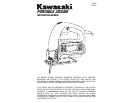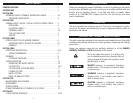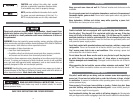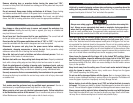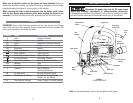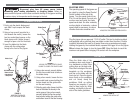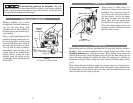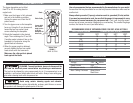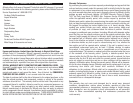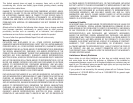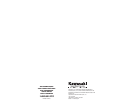
SPECIFIC SAFETY RULES AND/OR SYMBOLS
Hold tool by insulated gripping surfaces when performing an operation where the
cutting tool may contact hidden wiring. Contact with a “live” wire will also make
exposed metal parts of the tool “live” and shock the operator.
IMPORTANT SAFETY RULES FOR JIGSAWS
Always wear safety goggles or other approved eye protection when using this
tool. Always use an appropriate dust mask or respirator during operations
where dust can be generated. To reduce exposure to these chemicals always
work in a well ventilated area. Use approved safety equipment and dust masks
that are specially manufactured to filter out microscopic particles.
Hold the Jigsaw by the insulated gripping surfaces when performing an opera-
tion where the blade may contact hidden wiring or the tool power cord. Contact
with a "live" electrical wire will make exposed metal parts of the jigsaw "hot" and cre-
ate a potential for electrical shock to the operator. Do not cut into existing walls or
other blind areas where existing electrical wires may be present. If this situation is
necessary, remove all fuses and/or turn all circuit breakers off in the work area. After
cuts have been completed in the blind areas, inspect to ensure that no electrical wire
was cut or nicked before reinstalling fuses and/or engaging circuit breakers.
Never leave the jigsaw with the trigger left in the locked "ON" position. Before
plugging in the jigsaw, inspect to make sure the trigger lock is in the "OFF" posi-
tion. Accidentally plugging the jigsaw in with the trigger lock engaged can result in
premature starting of the tool, which can cause damage to the tool and/or serious
injury to the operator.
Keep hands away from the cutting area. Do not reach under material being cut
while the jigsaw is running. Serious injury could occur. Always turn the jigsaw
"OFF" before inspecting the cutting area.
Do not use dull or damaged blades with the jigsaw. Bent or damaged blades can
break or cause a kickback resulting in serious injury to the operator. Dull blades will
cause the jigsaw to perform improperly and may damage the tool.
Before starting to cut with the jigsaw, turn it "ON" and allow the blade to come to
full speed. The jigsaw can chatter or vibrate if the blade speed is too slow at the start of
the cut. This can cause the jigsaw to kickback and damage the work area or cause injury.
Always secure working material before attempting to make a cut with the jigsaw.
Never hold the material with your free hand or across your legs. Small or thin mate-
rial may flex or vibrate causing loss of control and possible injury.
Remove adjusting keys or wrenches before turning the power tool “ON”.
A wrench or a key that is left attached to a rotating part of the power tool may result
in personal injury.
Do not overreach. Keep proper footing and balance at all times. Proper footing
and balance enables better control of the power tool in unexpected situations.
Use safety equipment. Always wear eye protection. Dust mask, non-skid safety
shoes, hard hat or hearing protection must be used for appropriate conditions.
TOOL USE AND CARE
Use clamps or other practical ways to secure and support the workpiece to a
stable platform. Holding the work by hand or against your body is unstable and
may lead to loss of control.
Do not force tool. Use the correct tool for your application. The correct tool will
do the job better and safer at the rate for which it is designed.
Do not use the tool if the power switch does not turn it “ON” or “OFF”. Any tool that
cannot be controlled with the switch is dangerous and must be repaired.
Disconnect the power cord plug from the power source before making any
adjustments, changing accessories or storing the tool. Such preventive safety
measures reduce the risk of starting the tool accidentally.
Store idle tools out of reach of children and other untrained persons. Tools are
dangerous in the hands of untrained users.
Maintain tools with care. Keep cutting tools sharp and clean. Properly maintained
tools with a sharp cutting edge are less likely to bind and are easier to control.
Check for misalignment or binding of moving parts, breakage of parts, and any
other condition that may affect the tool’s operation. If damaged, have the tool
serviced before using. Many accidents are caused by poorly maintained tools.
Use only accessories that are recommended by the manufacturer for your model.
Accessories that may be suitable for one tool may create a risk of injury when used
on another tool.
SERVICE
Tool service must be performed only by qualified repair personnel. Service or
maintenance by unqualified personnel may result in a risk of injury.
When servicing a tool, use only identical replacement parts. Follow instructions
in the Maintenance section of this manual. Use of unauthorized parts or failure to
follow Maintenance Instructions could create a risk of shock or injury.
5 6



